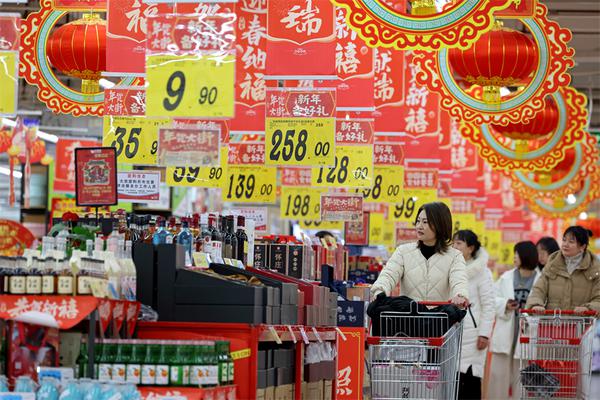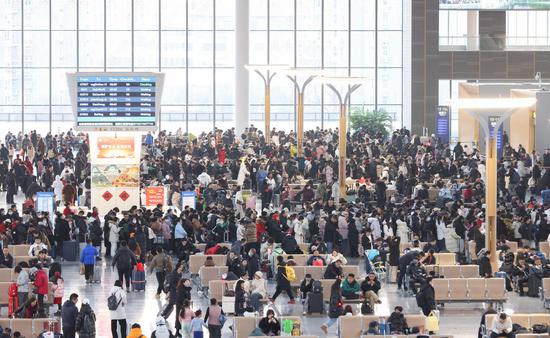
Shoppers seen at a supermarket in Zaozhuang, Shandong province. (SUN ZHONGZHE/FOR CHINA DAILY)
Chinese supermarket chains have reported increases in both visitor numbers and online sales, with three out of four that undertook adjustments and renovations in 2024 achieving growth, according to a report by the China Chain Store and Franchise Association.
The findings highlight a growing focus on maximizing existing resources to improve profitability in an increasingly competitive market.
The CCFA's annual survey on the business performance of chain supermarkets covered 47 companies operating over 10,000 stores, which collectively generated nearly 300 billion yuan ($41.4 billion) in annual sales.
Of the companies surveyed, 75 percent implemented store adjustments and renovations with strong results. Around three-quarters of these businesses reported growth in key performance metrics, the report stated.
While most experienced increases of about 20 percent, a notable number saw growth exceed 50 percent, reflecting the effectiveness of strategic investments in upgrading operations.
Regional leaders, including Yasi in Hubei province, Jiarong in Guangdong province, Dazhang in Henan province and Huaguan in Beijing, stood out for their robust performance, demonstrating their ability to innovate and adapt to evolving market conditions, said the report.
"As online traffic reaches its peak, some offline retailers are starting to see a rebound, but the market is becoming more polarized. Leading players like Bubugao or Better Life in Hunan province and some Yonghui stores have made adjustments, focusing on product quality, customer experience and service rather than simply competing on low prices," said Jason Yu, general manager of CTR Marketing Research.
"They are using unique value propositions to win over customers and build new core competitiveness. In third — and fourth-tier markets, companies like Pangdonglai (Henan province), Xinyulou (Hebei province) and Beauty Group (Liaoning province) are excellent examples of this success."
Kantar Worldpanel said that increased consumption in the lower-tier market also contributed significantly to the overall growth of modern trade, with sales in the first three quarters increasing by 3.6 percent.
In 2024, 38.2 percent of surveyed supermarket chains by CCFA achieved year-on-year growth in total sales, driven primarily by enhanced operational efficiency rather than store network expansion.
Online sales were a bright spot, with nearly half of the surveyed companies achieving year-on-year growth in this segment.
Among them, one-third reported growth exceeding 20 percent, particularly in second — and third-tier cities, said the report.
Supermarket chains have seen a recovery in foot traffic. While about 51.1 percent saw a rebound in visitor numbers, 21 percent of those with increased foot traffic did not experience corresponding sales growth, indicating a decline in average purchases per visitor.
Store openings and closures reflect the industry's cautious approach to expansion. While surveyed companies opened 737 new stores, the report said the sector has seen a shift moving away from aggressive regional expansion toward more targeted and sustainable growth strategies.
Among the surveyed companies, 36.2 percent pursued either expansion or contraction strategies, while 27.7 percent focused on stable operations within existing markets.
This year, the CCFA listed several key priorities in the transformation of procurement models, organizational optimization and store upgrades.


















































 京公网安备 11010202009201号
京公网安备 11010202009201号